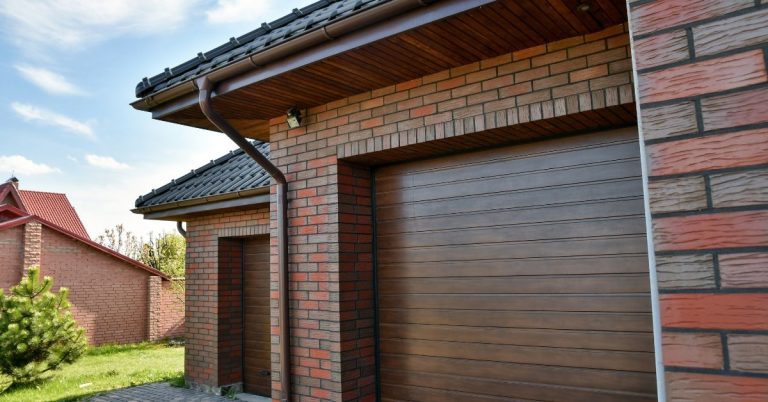Is your garage door keypad not working? A garage door keypad is the primary method for accessing the garage door without using a key or remote. When a keyless garage door opener is not working, the garage door’s entire functionality is disrupted. If you are having trouble controlling the garage door without a keypad and have tried multiple solutions, but your garage door keypad is still not working, then you have come to the right place for answers. Is your Chamberlain keypad not working or the LiftMaster keypad malfunctioning? Most of the keypad-related concerns can be resolved quickly, so don’t get panicked and read through to the end to explore the six quick-fix processes that you can try before calling the experts.
1. Check the Keypad Batteries
What to do when the keypad for the garage door is not working? Troubleshooting the garage door keypad battery is the most common solution. If after attempting several steps, the keypad batteries still fail to function. You need to check if the batteries are functioning properly or if they are depleted. Typically, common garage door keypads use 9V or AA batteries, which will lose power over time and may lead to unresponsive buttons or intermittent functionality.
- First, open the keypad cover.
- Then remove the old batteries and replace them with the new ones.
- Wait for at least 2 minutes, then try to insert the code again.
- This quick-fix problem resolves the majority of the keypad issues.
2. Inspect the Entire Keypad for Physical Damages
Garage door keypads are typically mounted outside, leaving them exposed to various weather conditions like harsh rain, snow, and external dirt. Over time, this exposure to various weather can cause wear and tear on both the exterior and interior components of the keypad.
If you find any signs of cracked or worn-out buttons and water intrusion, insects can even nest in the keypad, hindering its performance. Additionally, heavily used keypads may exhibit stuck buttons that no longer register when pressed.
- You have to perform a close inspection of the keypad.
- Press each button individually to check for sticking or a lack of tactile feedback.
- You can use a soft cloth and dampen it with good electrical cleaning alcohol to clean the surface.
Avoid using water or harsh chemicals if you notice any signs of damage; rust and cracked housing replacement might be the best option.
3.Try to Reprogram the Keypad
Sometimes, the problems are not limited to hardware-related issues. The issue can occur if the keypad loses synchronization with the garage door opener. This scenario can also happen after battery changes, power outages, or even due to electrical interference.
Reprogramming the keypad can often establish a connection with the garage door opener. Each brand, such as Chamberlain and LiftMaster, has a similar process.
- Locate the learning button on the opener.
- Press and release the learn button a light should start blinking, indicating it’s received a new code.
- You can wait at least 30 seconds, then enter a fresh 4-digit code.
- Press and hold the enter button for one second. Wait until the garage door opener light starts to blink or you hear the clicking sound.
After the successful reprogramming, test the functions of the garage door keypad.
4.Remove Wireless Blockage
Garage door keypads work by sending a wireless signal to the opener units. If the signal is uninterrupted or blocked, the opener may not receive the code even though the keypad appears to be functioning properly.
Surrounding security systems or Wi-Fi routers may interfere with the keypad signal on a cordless phone. Metal objects or dense concrete walls within the keypad and opener can reduce the signal potential or block the signal communication.
- Always make sure your garage door keypad is installed within the suggested range of the opener.
- Inspect whether it is within the limits or not.
- If the keypad is positioned far away from the metal siding, consider repositioning it.
- You can also temporarily unplug the nearby electronic devices to block any potential signal interference and then check the system.
- If required, you can invest in a signal booster designed for the garage door openers.
5. Reset Your Garage Door Opener System
Is your garage door opener keypad not working due to connection issues? Now it’s the time to explore some technical troubleshooting solutions that can be followed by technically sound property owners. If reprogramming the keypad doesn’t work, you may require a full system reset. Over prolonged periods of usage, garage door openers can develop electronic malfunctions, and a reset can clear out the bugs and offer the system a fresh start.
- First, start with unplugging the garage door opener from the power source for about 30 seconds.
- After plugging it in again, find the learn button and the reset button.
- Hold the button for at least 6 to 10 seconds until the indicator light goes away.
- The action will delete all kept keypad and remote control pairings.
You will then need to reprogram your keypad and remote. This process may take a few extra minutes, but it should resolve the persistent issues.
6. Check the Wiring or Internal Connections & Wired Models
Now most of the modern garage door keypads are wireless. But some of the older models or specially wired model systems are hardwired directly to the opener or wall control panel. Wiring problems often lead to malfunctions in hardwired keypad systems.
Multiple hardware issues can arise, such as loose components or wires that have deteriorated due to pests or exposure to weather. This damage could interfere with the electrical signal transmission. The following steps require sound knowledge of electrical circuits and wiring. Only proceed with the steps if you have experience in such tasks. If you lack experience, it is advisable to contact the experts at Steel City Garage Doors.
- Start with turning off the power source of the garage door opener before starting the wire inspection.
- Disable the garage door keypad, then look at the health of the wires and hardware terminals.
- If you find any loose connections, try to fix them or swap the frayed wires with new wire.
If you are confident of handling the electrical components, it’s best to consult the garage door technician for safety.
When Should You Call Steel City Garage Doors Professionals?
All of the above troubleshooting tips are useful. However, if the issue persists and you are unable to operate the keypad independently, you should seek professional assistance. Then it’s better to call the expert professionals of Steel City Garage Doors, who can resolve the error. If you encounter certain serious issues that you cannot resolve on your own, it is advisable to contact the professionals of Steel City Garage Doors.
Here are some of the instances when you should seek the help of the Steel City Garage Doors experts.
- Even after the above six troubleshooting processes, you face the same issues.
- You do not have any experience fixing garage door keypads.
- The problems might stem from a malfunctioning circuit board or a worn-out receiver in the opener units.
- If you lack the necessary expertise and tools to investigate the internal issues related to the garage door keypads.
A technician from Steel City Garage Doors will come to your location to diagnose the issues and determine if you need to replace the keypad or require more extensive garage door repairs. Try to avoid applying any DIY techniques for repairing the keypads. At first glance, these DIY techniques may seem convenient; however, if you are not an experienced technician, it is better to avoid attempting DIY keypad repairs to prevent any severe system damage.
In Conclusion
We understand when your garage keypad stopped working how frustrating and disruptive it might be. Most of the time, if changing the batteries in the garage door keypad doesn’t solve the issue, expert assistance is needed. These six are the best easy tips to restore the keypad’s overall functionality. If you still find yourself locked out and are experiencing multiple persistent issues, do not hesitate to contact the professional garage door experts at Steel City Garage Doors by calling (412) 504-7100 for immediate troubleshooting.
FAQs
Users will experience the error code 4-6 when the operator detects the safety sensors are blocked or not aligned when you are trying to close it.
If you have attempted to replace the batteries, clean the unit, and reprogram it without success, and your keypad is still malfunctioning, then it may be time to replace it. Then it may be the right time to replace it. Usually, a keypad lasts 8-10 years, but frequent glitches, physical damage, and weather can often lead to its failure. If your keypad has entirely failed and does not respond, then it’s a clear sign that you need a new one.
Your opener remote batteries will diminish over time and may need replacement. The first go-to solution is to try to replace the remote’s batteries and test it. Even after trying this solution, your garage door controller still may not be working. You will now be required to reprogram the remote, even if you have replaced the batteries.
Check the garage door opener manual. Go through the section that covers programming and reprogramming the remote. This section usually includes the remote code. If you do not have the manual, then you will get two options. One option is to find solutions on your garage door opener brand’s official website, and the other option is to call a Steel City Garage Doors expert for troubleshooting the garage door code.
The most typical cause of why your garage door opener keypad is not working is related to a dead battery. Most keypads utilize a 9-volt battery and some of the older models also depend on 12-volt batteries. If you have already replaced the batteries, then it is time to call an expert to troubleshoot the garage door.
If you have attempted to replace the batteries, clean the unit, and reprogram it without success, and your keypad is still malfunctioning, then it may be time to replace it. Then it may be the right time to replace it. Usually, a keypad lasts 8-10 years, but frequent glitches, physical damage, and weather can often lead to its failure. If your keypad has entirely failed and does not respond, then it’s a clear sign that you need a new one.




